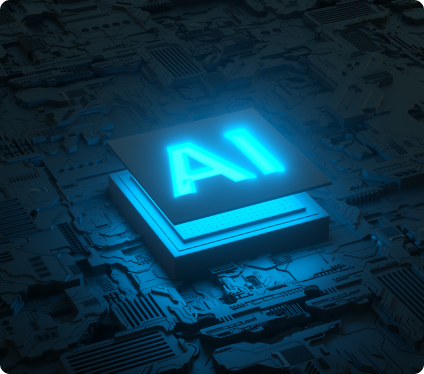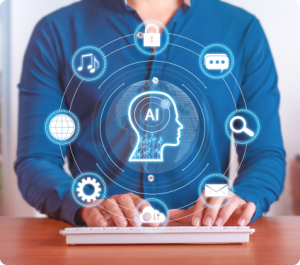This guide delves into the essence of enterprise AI – outlining its definition, benefits, implementation process, and challenges. Whether you are a business leader, a tech enthusiast, or someone looking to understand how AI can transform your organization, this comprehensive guide is designed to provide you with actionable insights.
What is Enterprise AI?
At its core, enterprise AI refers to the application of artificial intelligence (AI) technologies within an organizational context to solve complex business problems, optimize operations, and drive innovation.
Unlike consumer AI, which focuses on end-user applications like virtual assistants, enterprise AI is tailored to meet the specific needs of businesses. It encompasses a wide range of AI capabilities – such as machine learning, natural language processing, computer vision, intelligent document processing, intelligent automation, and robotic process automation – all aimed at enhancing enterprise functions.
What is enterprise-ready AI?
This specific category of AI goes beyond the mere implementation of AI tools and technologies. It involves developing and deploying solutions that are scalable, secure, and seamlessly integrated into the existing business processes of an enterprise.
Enterprise-ready AI must adhere to stringent requirements for data privacy, regulatory compliance, and interoperability with other enterprise systems. It should be robust enough to handle the vast amounts of data typical of large organizations and flexible enough to adapt to the dynamic business environment.
Key characteristics of enterprise-ready AI include:
- Scalability: The ability to process large volumes of data and manage increasing workloads without compromising performance.
- Security: Ensuring data integrity and protection against breaches through advanced encryption and security protocols.
- Reliability: Providing consistent and accurate outputs, minimizing errors, and ensuring high availability.
- Interoperability: Seamlessly integrating with existing IT infrastructure and other enterprise applications.
Understanding the AI Enterprise Workflow
The AI enterprise workflow is a systematic process that involves several stages, from data collection to the deployment of AI models. It would be helpful to understand this workflow to successfully implement AI in your business.
- Data collection and preparation: The first step involves gathering data from various sources within or outside the organization. This data is then cleaned, formatted, and enriched to ensure it is suitable for analysis. High-quality data is the foundation of any successful AI initiative.
- Exploratory Data Analysis (EDA): In this stage, data scientists perform a detailed analysis to understand the data’s characteristics and uncover patterns. EDA helps in identifying relationships, trends, and anomalies that can inform the development of AI models.
- Model development: Using the insights gained from EDA, data scientists develop machine learning models. This involves selecting appropriate algorithms, training the models on historical data, and fine-tuning them to improve accuracy.
- Model validation and testing: Before deploying models into production, they must be rigorously tested and validated to ensure they perform well on new, unseen data. This step helps in identifying potential issues and refining the models.
- Deployment: Once validated, AI models are deployed into the production environment. This involves integrating the models with existing systems and setting up infrastructure to support real-time data processing.
- Monitoring and maintenance: Post-deployment, it is essential to continuously monitor the performance of AI models. Regular updates and maintenance are necessary to adapt to changing data patterns and ensure ongoing accuracy.
What is the Difference Between Enterprise AI and Consumer AI?
While both enterprise AI and Consumer AI leverage similar underlying technologies, they differ significantly in their applications, requirements, and impact.
1. Target audience
Enterprise AI is designed for businesses and organizations. It focuses on optimizing internal processes, enhancing operational efficiency, and driving strategic decisions. Examples include invoice processing and predictive maintenance in manufacturing, customer onboarding and fraud detection in financial services, and customer service automation in retail.
On the other hand, consumer AI is aimed at individual consumers. It focuses on improving user experiences, providing personalized services, and enhancing everyday tasks. Examples include virtual assistants like Siri and Alexa, recommendation engines on streaming platforms, and personalized ads on social media.
2. Data requirements
Enterprise AI relies on large volumes of structured and unstructured data from various sources within and outside the enterprise. The data is often sensitive and requires strict privacy and security measures. However, consumer AI typically uses data generated by individual users, such as search history, social media activity, and purchasing behavior. While privacy is also a concern, the scale and nature of data differ from enterprise settings.
3. Complexity and integration
Enterprise AI involves complex integrations with your existing IT infrastructure, ERP systems, and other enterprise applications. It requires extensive customization to fit specific business needs. As you might expect, consumer AI involves lesser complex integrations, focusing more on user-friendly interfaces and ease of access through consumer devices and platforms.
4. Deployment and maintenance
Deploying enterprise AI is much more intricate, requiring collaboration between data scientists, IT teams, and business stakeholders. Also, ongoing maintenance is critical to adapt to changing business requirements and data dynamics. Consumer AI deployment is usually handled end to end by technology vendor companies.
How Do Enterprises Use AI Today? 8 Popular Use Cases
The transformative potential of AI is being realized across various industries, with businesses leveraging its capabilities to enhance operations, innovate, and stay competitive. Here are some of the most popular use cases of AI in enterprises today:
1. Predictive maintenance
In manufacturing and utilities, AI-driven predictive maintenance models analyze data from equipment sensors to predict failures before they occur. This proactive approach reduces downtime, lowers maintenance costs, and extends the lifespan of machinery.
2. Customer service
AI-powered virtual assistants are revolutionizing customer service by providing instant responses to common queries, handling transactions, and escalating complex issues to human agents. This not only improves customer satisfaction but also reduces operational costs.
3. Fraud detection
Financial institutions use AI to detect fraudulent activities by analyzing transaction patterns and flagging anomalies. Machine learning algorithms continuously learn from new data, enhancing their ability to identify and prevent fraud in real-time.
4. Supply chain optimization
AI enhances supply chain efficiency by predicting demand, optimizing inventory levels, and improving logistics. By analyzing historical data and market trends, AI models help businesses make data-driven decisions, reducing costs and improving delivery times.
5. Personalized marketing
Retailers and e-commerce platforms use AI to analyze customer behavior and preferences, delivering personalized product recommendations and targeted marketing campaigns. This increases engagement, boosts sales, and enhances customer loyalty.
6. Talent acquisition
AI streamlines the recruitment process by automating resume screening, matching candidates with job requirements, and even conducting initial interviews using natural language processing. This reduces the time-to-hire and helps identify the best talent efficiently.
7. Financial forecasting
AI aids financial planning by analyzing historical data, market conditions, and economic indicators to generate accurate forecasts. This helps businesses in budgeting, risk management, and strategic decision-making.
8. Healthcare diagnostics
AI-powered diagnostic tools assist medical professionals by analyzing medical images, patient histories, and clinical data to identify diseases and recommend treatments. This improves diagnostic accuracy and speeds up patient care.
9. Invoice processing
AI helps Finance & Accounting teams achieve straight-through invoice processing. Enterprise AI solutions come with pre-packaged configurable supplier portal, AI-based invoice extraction, built-in processing rules, automated workflows, and integrations to various ERP and payment systems.
10. Client Onboarding
Enterprise AI solutions fast-track the entire client onboarding process. They help your business to start delivering value to clients earlier and get them up and running quicker with your products and services.
Examples of Enterprise AI Across Industries
To better understand enterprise AI’s importance in industries, let us look at a few pertinent examples:
Example 1: Financial Services
AI-powered platforms and pre-built intelligent applications are enabling financial services firms to simplify operational processes and workflows end-to-end – from onboarding to servicing – so they can reallocate time spent on repetitive tasks to building customer relationships.
Example 2: Finance & Accounting
Enterprise AI solutions enable the CFO’s Office and Finance & Accounting teams to move from automated to an autonomous experience. They consolidate data across enterprise functions seamlessly, and connect people and processes across the organization, thus powering highly efficient, intelligent finance operations.
Example 3: Media
Enterprise AI injects artificial intelligence into end-to-end automations for a range of buy-side and sell-side media planning and operations processes. AI solutions create custom process automations that leverage your existing systems and workflows. These solutions are easy to onboard and quick to translate into a clear and measurable ROI.
Example 4: Manufacturing
AI is transforming production processes, quality control, and supply chain management. AI-driven predictive maintenance models analyze sensor data to forecast equipment failures and schedule timely maintenance, reducing downtime and repairing costs. Computer vision systems inspect products for defects, ensuring high-quality standards.
Example 5: Non-Profits
Nonprofits leverage AI to enhance their outreach, optimize resource allocation, and measure impact. For instance, AI can analyze donor data to identify potential major donors and tailor fundraising campaigns. AI-driven chatbots assist in engaging with beneficiaries and providing information and support. By automating administrative tasks, AI allows non-profits to focus more on their mission and impact.
Example 6: Hospitality
The hospitality industry utilizes AI to enhance guest experiences, optimize operations, and personalize marketing efforts. AI and machine learning algorithms analyze guest preferences and behavior to deliver personalized experiences, from tailored room settings to customized offers. AI also optimizes pricing strategies by analyzing market trends, demand, and competitor rates.
By understanding how AI can be applied in your specific industry, you can unlock new opportunities and transform your business operations. As we continue this exploration, we will delve into the enterprise AI implementation process, providing you with a comprehensive roadmap to navigate the AI journey effectively.
How Do You Implement Enterprise AI? A Step-by-Step Tutorial
Implementing enterprise AI can seem daunting, but with a structured approach, you can effectively and seamlessly integrate AI into your business operations. Here is a step-by-step tutorial to guide you through the process:
1. Define your objectives
Start with pinpointing the specific business problems you aim to solve with AI. Clear, measurable objectives will guide your AI strategy and help quantify success. Are you looking to enhance onboarding experience and customer service, optimize supply chains, or predict market trends? Precise goals are essential.
2. Assemble a skilled team
Form a cross-functional team of data scientists, AI specialists, software engineers, and domain experts. This multi-disciplinary approach ensures that the AI solution is technically sound and aligned with business needs. Collaboration between IT and business units is crucial for effective implementation.
3. Assess your data
Evaluate the quality, diversity, and volume of your data. AI models thrive on large datasets, so ensure your data is clean, well-organized, and relevant. Implement data governance frameworks to maintain data integrity and compliance with regulations.
4. Choose the right tools and technologies
Select AI tools and platforms that align with your objectives and existing IT infrastructure. Consider factors such as scalability, ease of integration, support for various AI techniques (like deep learning or natural language processing), and vendor reliability.
5. Develop and train AI models
Using your prepared data, develop AI models tailored to your specific business needs. Employ machine learning algorithms, train your models on historical data, and perform rigorous testing to validate their accuracy. Techniques like cross-validation and hyperparameter tuning can enhance model performance.
6. Integrate AI into business processes
Seamlessly embed your AI models into existing workflows. This may involve developing custom APIs, ensuring interoperability with ERP systems, and creating user-friendly interfaces for non-technical stakeholders. Pilot programs can help identify integration issues early.
7. Monitor and maintain AI systems
Post-deployment, continuously monitor your AI models to ensure they perform as expected. Set up automated monitoring tools to track model accuracy, performance, and drift. Regularly update and retrain models to adapt to new data and changing business conditions.
Challenges to Enterprise AI Adoption and How to Solve Them
Adopting AI in your enterprise comes with its own set of challenges. Here is how you can address them:
- Poor data quality and lack of sufficient data can hinder AI performance. Invest in data cleaning and preparation processes. Use data augmentation techniques and leverage external datasets to enrich your data pool. Implement robust data management practices to ensure ongoing data quality.
- Integrating AI with legacy systems can be complex. Choose AI solutions that offer flexible APIs and middleware that can bridge new AI capabilities with your existing infrastructure. Consider microservices architecture to facilitate integration and scalability.
- Lack of skilled personnel can slow down AI adoption. Invest in comprehensive training programs for your current staff. Partner with universities for research collaboration and internships. Hiring external experts or consulting firms can provide the necessary expertise during initial phases.
- High initial costs and unclear ROI can deter AI investments. Start with small, high-impact pilot projects to demonstrate value. Use these early successes to build a business case for broader AI initiatives. Implement cost-benefit analysis frameworks to quantify AI’s potential impact.
- Resistance to change can impede AI adoption. Communicate the strategic importance and benefits of AI clearly to all stakeholders. Provide training sessions, workshops, and continuous support to employees. Foster a culture of innovation and openness to innovative technologies.
In Conclusion: Why Enterprise AI is Central to the Future of Automation
p class=”mb-20″>Enterprise AI is not just a technological advancement – it is a strategic imperative for the future of automation. By automating complex processes, enhancing decision-making, and driving innovation, AI enables you to stay competitive in an increasingly digital world.
Planning to integrate AI into your operations, you unlock new opportunities for growth, efficiency, and customer satisfaction?




